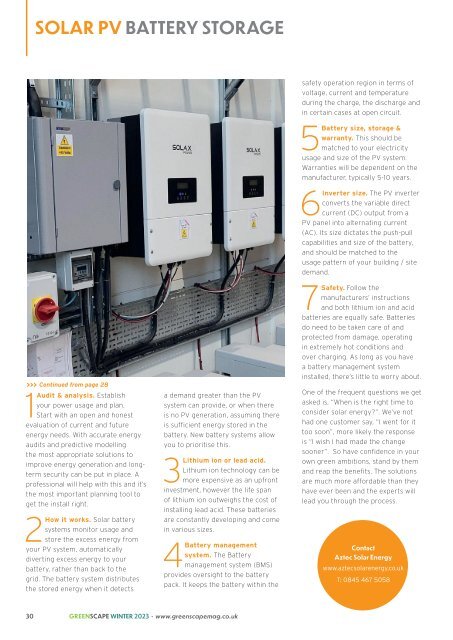Winter 2023
You also want an ePaper? Increase the reach of your titles
YUMPU automatically turns print PDFs into web optimized ePapers that Google loves.
SOLAR PV BATTERY STORAGE<br />
>>> Continued from page 28<br />
1<br />
Audit & analysis. Establish<br />
your power usage and plan.<br />
Start with an open and honest<br />
evaluation of current and future<br />
energy needs. With accurate energy<br />
audits and predictive modelling<br />
the most appropriate solutions to<br />
improve energy generation and longterm<br />
security can be put in place. A<br />
professional will help with this and it’s<br />
the most important planning tool to<br />
get the install right.<br />
2<br />
How<br />
it works. Solar battery<br />
systems monitor usage and<br />
store the excess energy from<br />
your PV system, automatically<br />
diverting excess energy to your<br />
battery, rather than back to the<br />
grid. The battery system distributes<br />
the stored energy when it detects<br />
a demand greater than the PV<br />
system can provide, or when there<br />
is no PV generation, assuming there<br />
is sufficient energy stored in the<br />
battery. New battery systems allow<br />
you to prioritise this.<br />
3<br />
Lithium<br />
ion or lead acid.<br />
Lithium ion technology can be<br />
more expensive as an upfront<br />
investment, however the life span<br />
of lithium ion outweighs the cost of<br />
installing lead acid. These batteries<br />
are constantly developing and come<br />
in various sizes.<br />
4<br />
Battery<br />
management<br />
system. The Battery<br />
management system (BMS)<br />
provides oversight to the battery<br />
pack. It keeps the battery within the<br />
safety operation region in terms of<br />
voltage, current and temperature<br />
during the charge, the discharge and<br />
in certain cases at open circuit.<br />
5<br />
Battery<br />
size, storage &<br />
warranty. This should be<br />
matched to your electricity<br />
usage and size of the PV system.<br />
Warranties will be dependent on the<br />
manufacturer, typically 5-10 years.<br />
6<br />
Inverter<br />
size. The PV inverter<br />
converts the variable direct<br />
current (DC) output from a<br />
PV panel into alternating current<br />
(AC). Its size dictates the push-pull<br />
capabilities and size of the battery,<br />
and should be matched to the<br />
usage pattern of your building / site<br />
demand.<br />
7<br />
Safety.<br />
Follow the<br />
manufacturers’ instructions<br />
and both lithium ion and acid<br />
batteries are equally safe. Batteries<br />
do need to be taken care of and<br />
protected from damage, operating<br />
in extremely hot conditions and<br />
over charging. As long as you have<br />
a battery management system<br />
installed, there’s little to worry about.<br />
One of the frequent questions we get<br />
asked is, “When is the right time to<br />
consider solar energy?”. We’ve not<br />
had one customer say, “I went for it<br />
too soon”, more likely the response<br />
is “I wish I had made the change<br />
sooner”. So have confidence in your<br />
own green ambitions, stand by them<br />
and reap the benefits. The solutions<br />
are much more affordable than they<br />
have ever been and the experts will<br />
lead you through the process.<br />
Contact<br />
Aztec Solar Energy<br />
www.aztecsolarenergy.co.uk<br />
T: 0845 467 5058<br />
30 GREENSCAPE WINTER <strong>2023</strong> • www.greenscapemag.co.uk

















